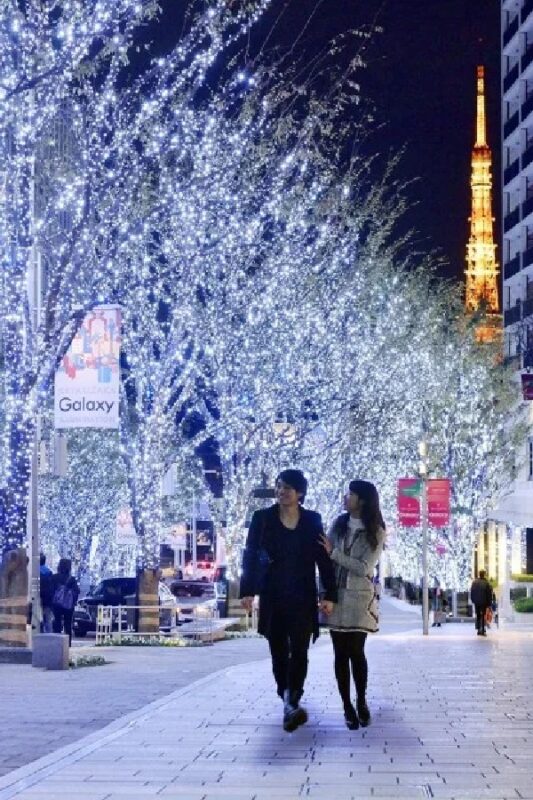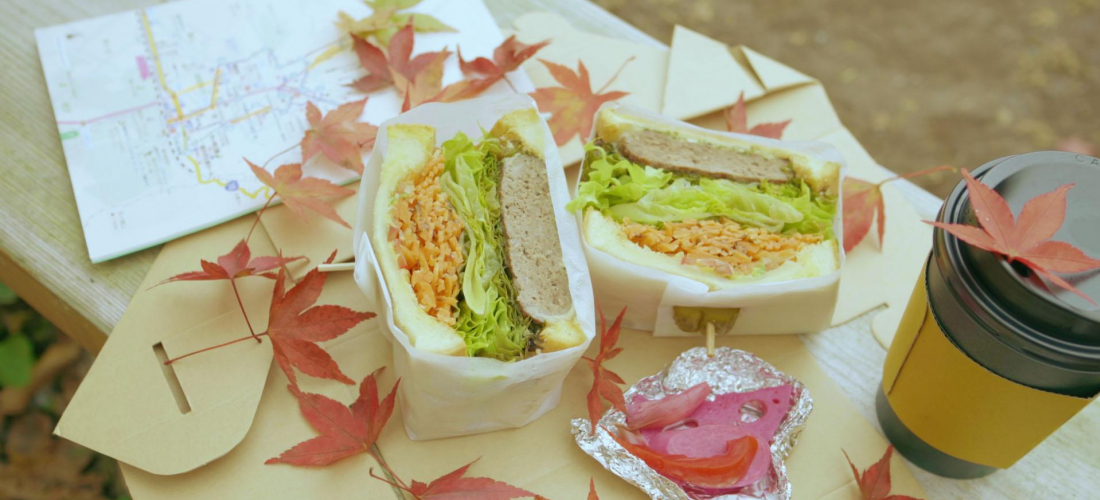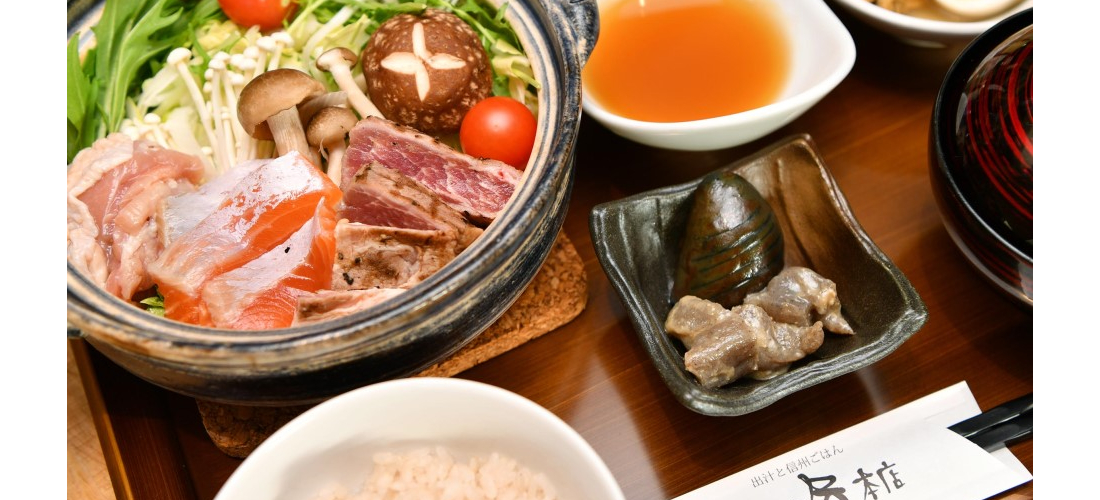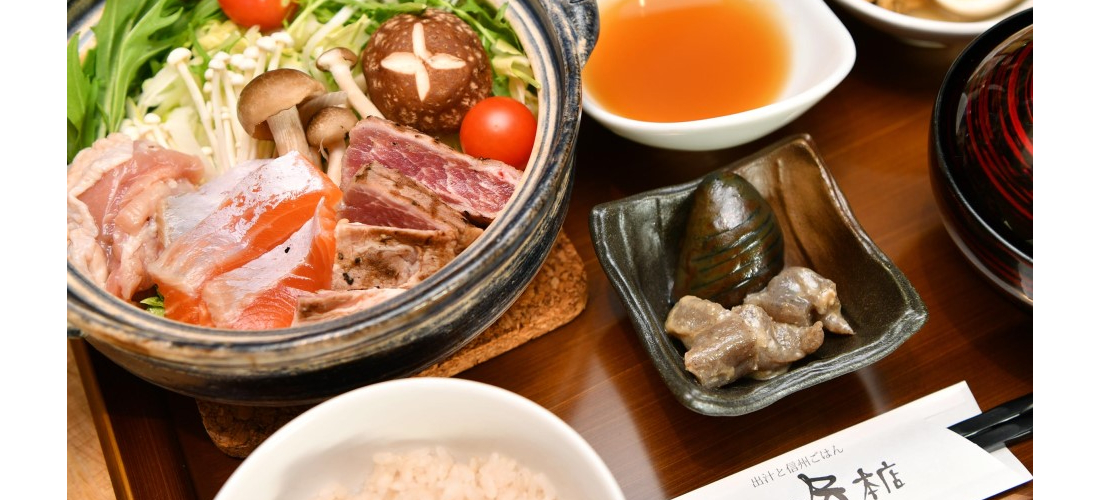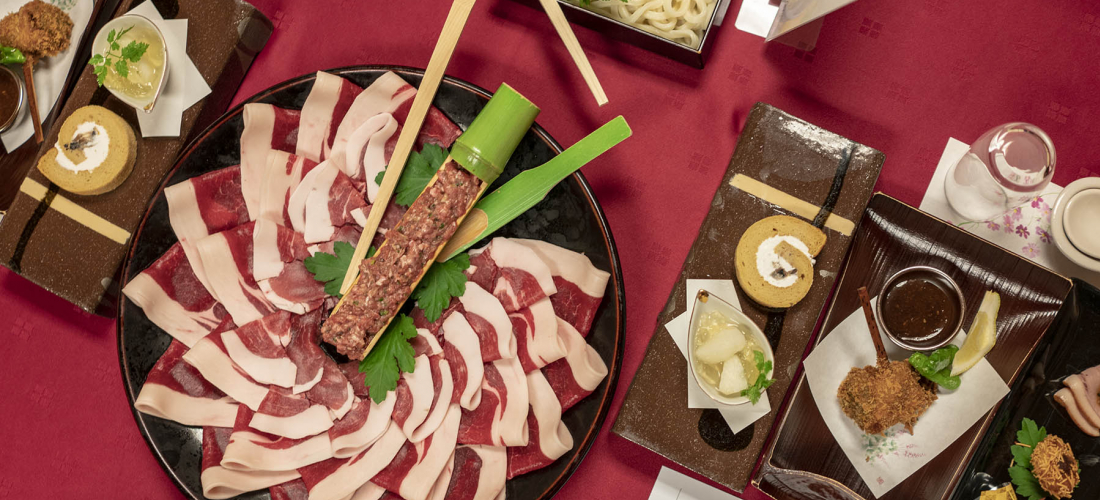
CONTENTS
Kyoto – home to temples and shrines, traditional narrow alleys full of old machiya-style homes, maiko, traditional arts, refined cuisine, and also… wild game? It turns out that while many people’s Japan travel itineraries include trips to Kyoto’s Golden Pavilion of Kinkakuji or Fushimi Inari Shrine, they’re missing out on a whole chunk of the Kyoto area, and all it has to offer (including some unique gibier game meat culture)! So last fall, the JAPANKURU team took a trip west to Kyoto, and then up north to its Tamba region, once its own province bordering the Sea of Japan.
Wild Game, Traditional Cuisine, and Northern Kyoto
Thanks to northern Kyoto’s rich natural resources and welcoming climate, wild animals and humans alike thrive between the mountains and the sea. The locals work hard to maintain that balance with the environment of their beloved hometowns, so we headed over to see just what the people of Tamba were up to, and learn a whole lot about “gibier.”

Gibier is a French term referring to wild game meat, connected to a culture reaching far back to the culinary traditions of European nobility. While the word isn’t used much in English, it has been adopted into the Japanese vocabulary. Now it’s commonly used to talk about Japan’s own wild game traditions and cuisine, focused on ingredients like venison and wild boar, a culture with its own venerable history.
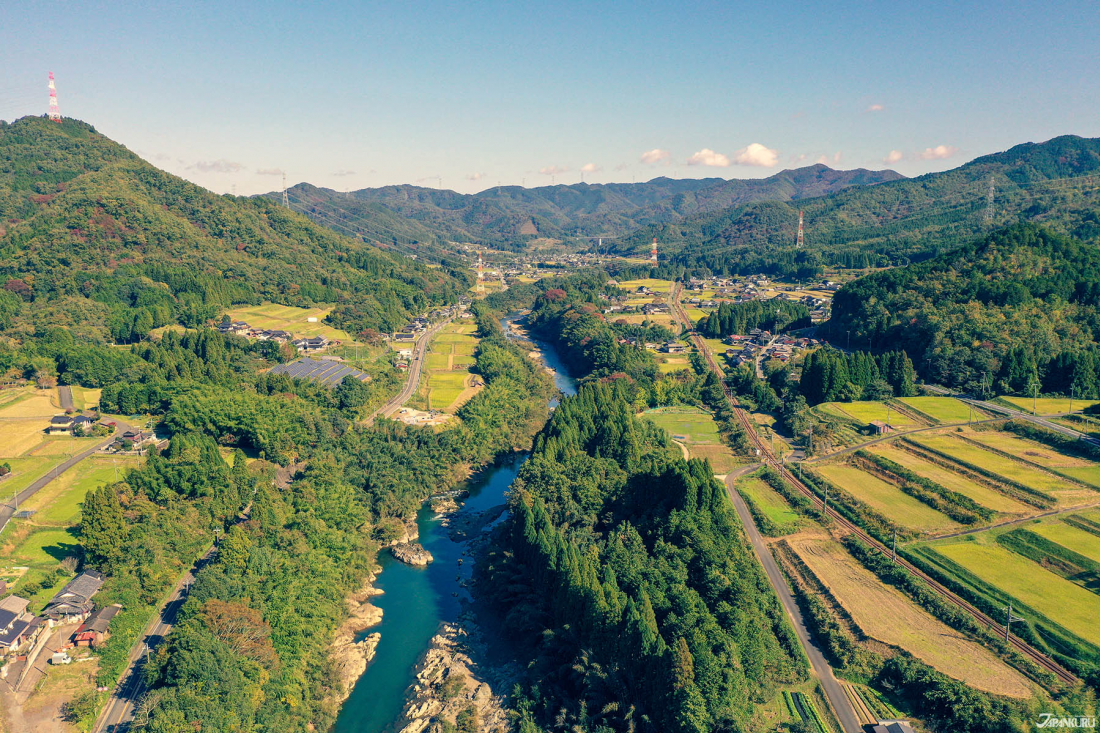
While Japan’s love for gibier has followed global trends, and the dishes have been slowly disappearing from menus since the Meiji period (1868 – 1912), there are still pockets of the tradition thriving around Japan, and locals trying to bring the cuisine back to the front of people’s minds. One of those modern gibier hotspots? Northern Kyoto, and the region that was once the ancient province of Tamba.
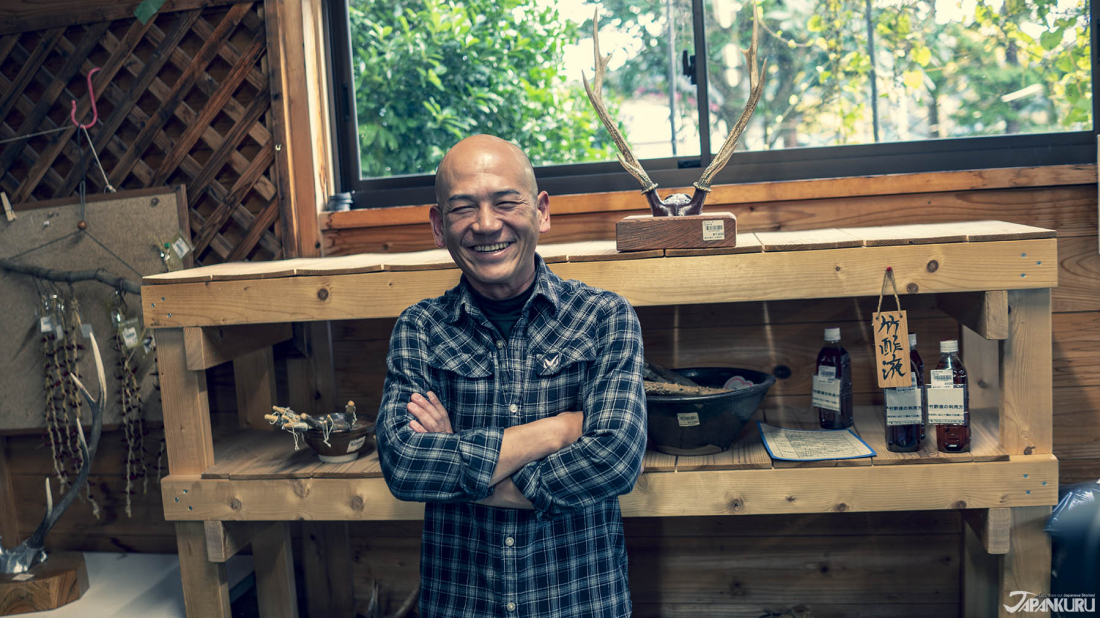
Throughout our trip to the region, we were fortunate enough to talk with some local experts: the people who work with Kyoto’s gibier every single day. One of those gibier pros was Kentaro Nakajima, hunter and chef. Nakajima first became interested in wild game meat through his work as a professional chef, and he now runs Kentaro’s Kyoto Gibier, which supplies local cooks both professional and amateur with fresh game meat. The perfect person to guide us as we explored the culture!
So it was Nakajima who we asked our first and most pressing question: why? Why, in this modern world where you can buy farm-raised meat at any grocery store, pre-cut and ready to cook, would the people of northern Kyoto hunt and cook local deer and wild boar?
“While ‘gibier’ originally refers simply to Europe’s wild game meat cuisine,” he told us, “in this part of Japan, we’ve been using the term to discuss how we want to encourage people to take advantage of the great game meat resources available to them locally, locavore-style.” Nakajima explained to us how working with wild game wasn’t just a novelty or a joke, it was their way of maintaining the local environment. When left to their own devices, the local deer and boar had started to become overpopulated, destroying the crops of local farmers and causing mayhem in the area. So making sure the animals are cooked and eaten kills two birds with one stone: solving the problems of overpopulation, and simultaneously providing locals with an eco-friendly local source of food, full of both nutrition and flavor.
↑ Check out the video we made during our trip to Kyoto!
A Gibier Food Tour
Thanks in part to all of Kentaro Nakajima’s work, gibier culture continues in the homes and restaurants of northern Kyoto. From small refrigerators in tiny local groceries to the tables of traditional fine dining establishments, we wanted to see local gibier in all its forms, so we set off to explore.
Oni-soba Noodles with Venison or Wild Boar Meatballs
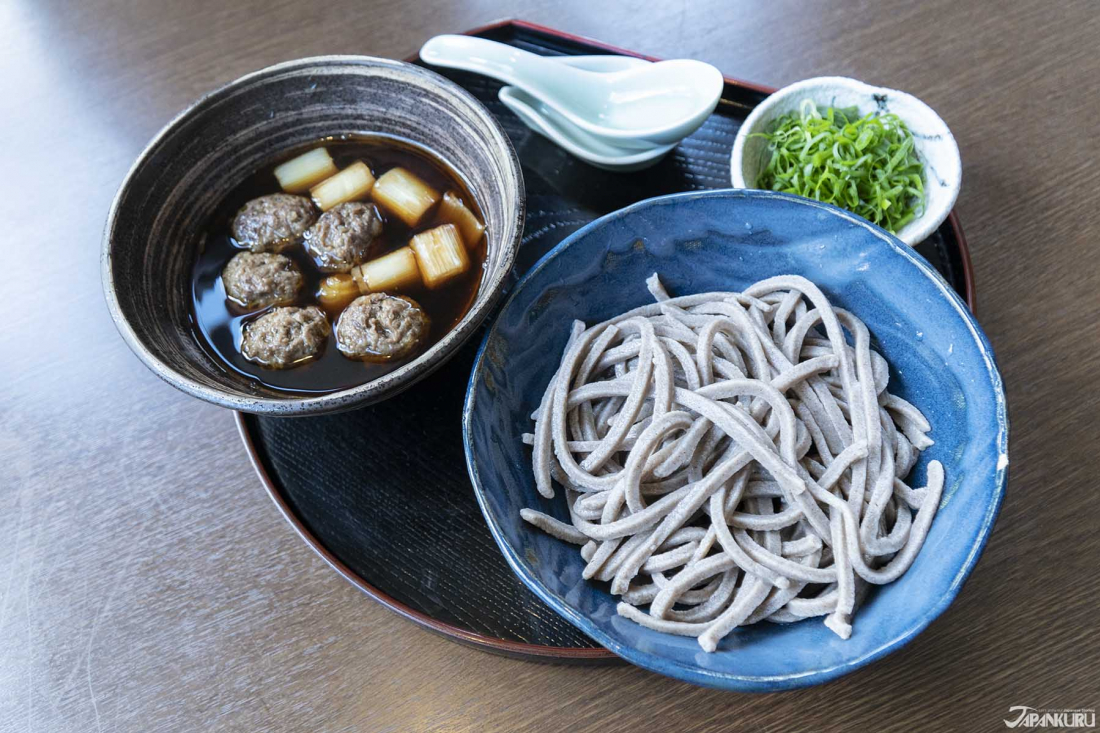
Our first taste of gibier came as a topping resting on a bed of oni-soba noodles. This soba, once served to the reigning daimyo lords of Tamba, is named after Japanese “oni” demons, and often eaten with gibier, like wild boar or venison. Compared to your average soba noodles, relatively thin buckwheat strands, these noodles are especially thick and chunky, with a satisfying bite and a rustic touch – the perfect thing to accompany rustic wild game.
So for lunch, we tried bowls of chilled noodles in a soy-based broth, with wild boar meatballs and slices of venison. Wild game meat has a reputation for being, well, gamy. In Japanese they refer to the meat as being “smelly,” or kusai (臭い). The thin slices of local deer meat that were our first taste of this northern Kyoto specialty, however, had none of that quality. Gently simmered in the gentle broth, any gaminess had cooked away, leaving a surprisingly tender cut of meat.

The fresh soba noodles of Onisobaya have been served here since the 1800s, but the restaurant is now run by staff who are both friendly and also have some pretty interesting backgrounds. Start up a conversation with Mami, the owner, and Nana-hime, the head chef, if you get a chance!
Onisobaya (大江山鬼そば屋)
1248 Kumohara, Fukuchiyama, Kyoto
Hours: 11:00 – 15:00 (closed Tuesdays & Wednesdays)
Official Website (jp)
Gibier Barbeque
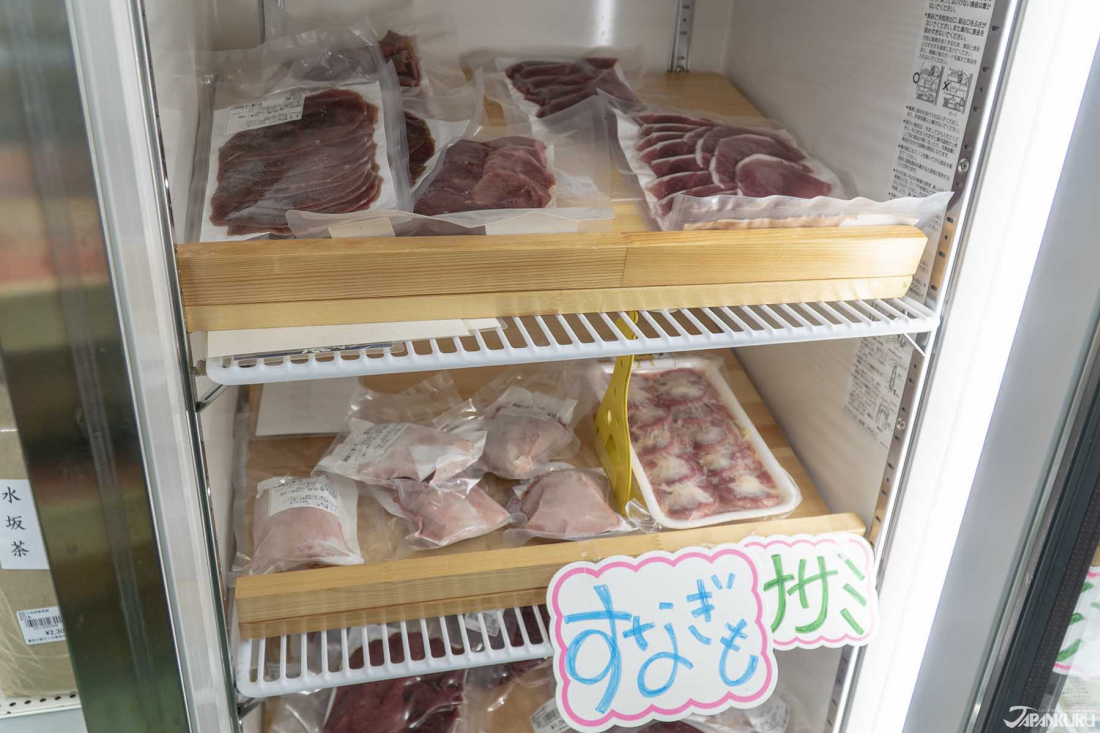
For our next meal, we decided to get a little more up close and personal with the ingredients we were so interested in. So we headed to a tiny local grocery that offers a whole host of produce grown nearby, and a refrigerator of wild game meat stocked by Kentaro Nakajima himself.
Here he told us how “the Tamba region has a great climate and natural features, which means not only do crops like rice and vegetables grow well, but the wild chestnuts and acorns are also full of flavor. The local deer and wild boar spend their lives feeding on these,” which apparently gives the meat great flavor.
After we explained our dinner plans – to try barbequing some of the meat ourselves, Nakajima recommended we go for the slightly fattier wild boar meat, which is more likely to turn out well on a grill. We took the liberty of picking up a little of everything, including the venison.
Yaku no Kogenichi Grocery (やくの高原市)
2171 Yakunocho Hirano, Fukuchiyama, Kyoto
Hours: 9:30 – 17:00 (closed 3rd Wednesday of the month)
Official Website
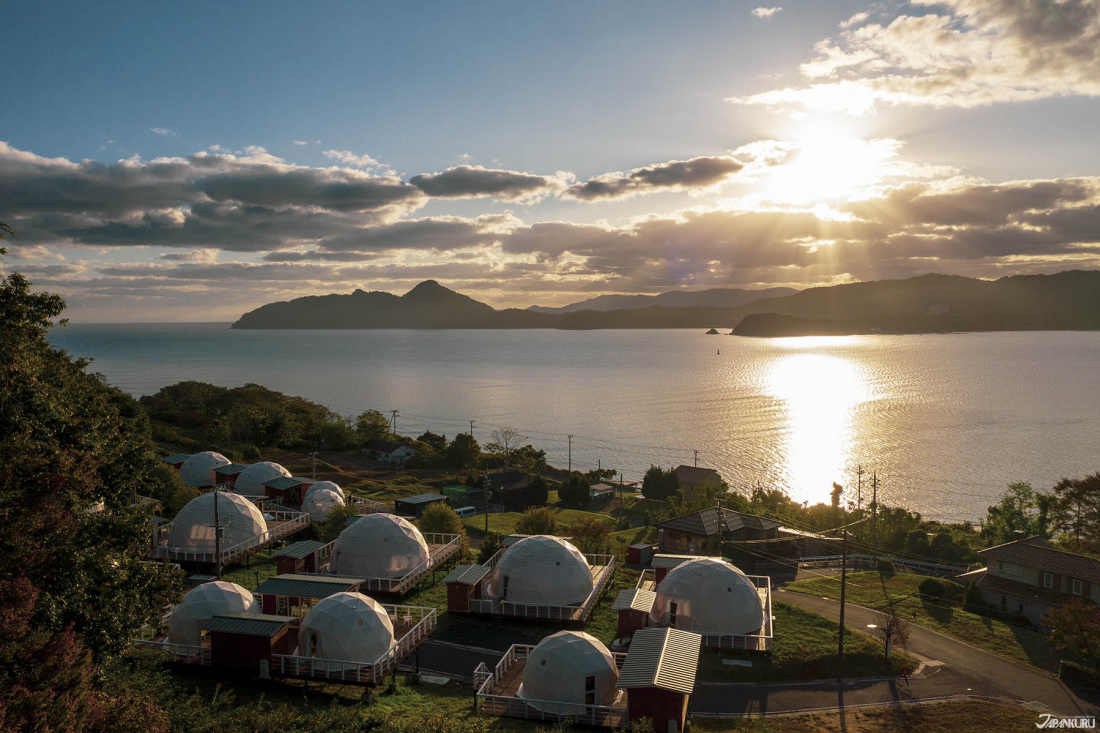
Our barbeque facility of choice? Farm Glamping Kyoto Amanohashidate, a very glam camping site indeed, made up of dome-shaped tents and kitchen shacks, all right on the glittering water. Most guests at this facility use the fancy grill and wood stove to cook a pretty impressive meal with ingredients provided by the glamping site itself. We, of course, decided to supplement that with our own array of gibier!
Farm Glamping Kyoto Amanohashidate
397-13 Nanbano, Miyazu, Kyoto
Official Website
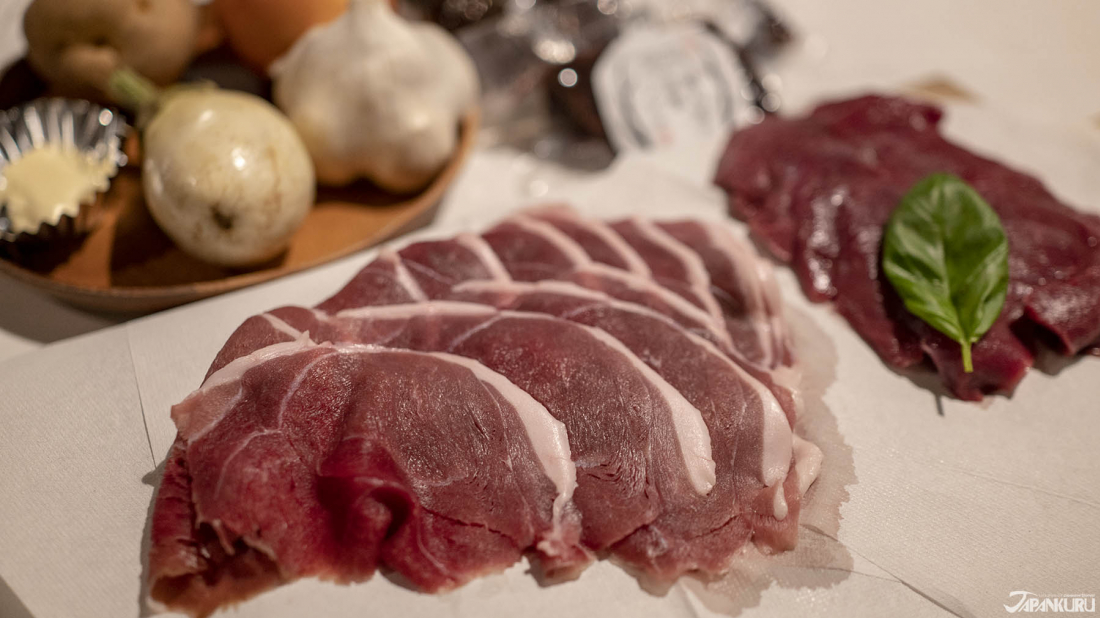
While our grilling skills were questionable, the quality of the meat shined through, delivering some really unique flavor, and making for a pretty fun barbecue.
Botan Nabe – Wild Boar Hotpot
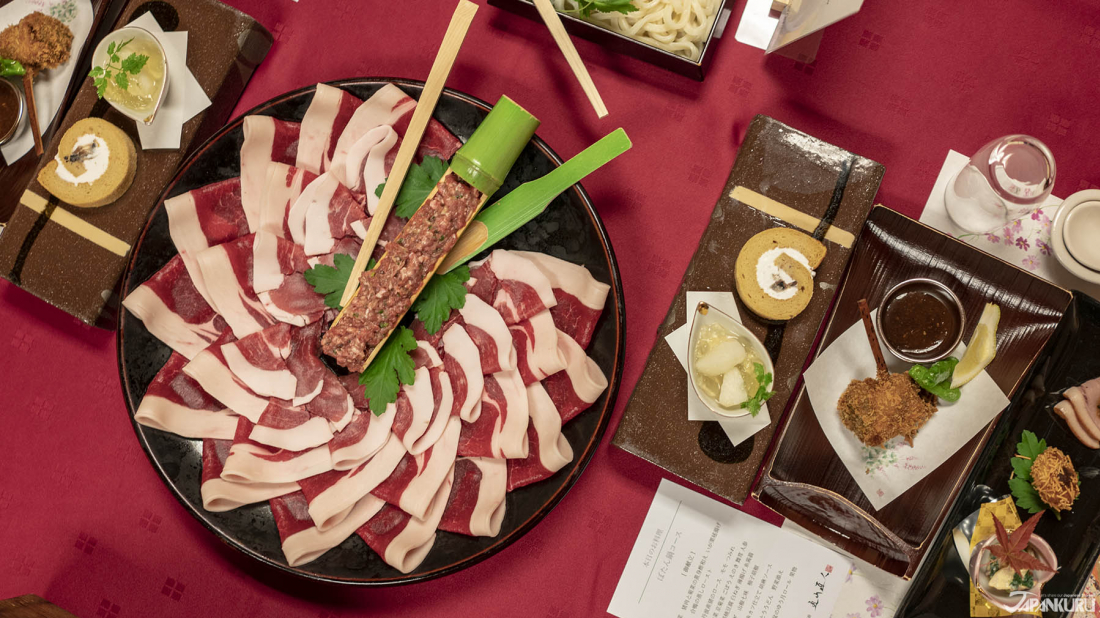
We really did our best preparing our own fairly lean cuts of wild boar, but we knew we also had to try the very best Japan has to offer when it comes to such a special ingredient. Kentaro Nakajima told us that the slices of vibrant red boar meat surrounded by a strip of white, the very best cut, are only found in winter, after the boar have been feeding heavily and putting on lots of fat for the cool months ahead. We were pleased to find that mid-fall was late enough, and so we went to try Japan’s most popular wild boar dish at Yuzuki, a restaurant specializing in some high-end Japanese food.

We were at Yuzuki to try “botan nabe” (牡丹鍋), or botan hotpot. This dish is centered around those fantastically vibrant cuts of wild boar meat, but botan doesn’t mean wild boar (wild boar is “inoshishi”, 猪)! Botan actually translates to “peony,” like the flower. The name harkens back to another time in Japanese history, when eating wild game was a certain kind of taboo, and so people referred to the dishes using euphemisms. Why “peony,” though? Well, the way the brightly colored meat is arranged on the dish when served raw did look an awful lot like flower petals, doesn’t it?
When we finally started swishing the delicately sliced meat into the simmering miso-based broth, and then tasting it, we were blown away by the flavor. Gone was any hint of gaminess – it was a lovely melding of savory, aromatic meat, stewed vegetables, and rich broth.
Yuzuki (ゆう月)
Yuri-16-1 Shichihyakkokucho, Ayabe, Kyoto
Hours: 11:30 – 15:00 / 18:00 – 22:00
Official Website
Venison Stew & Yakiniku Barbeque
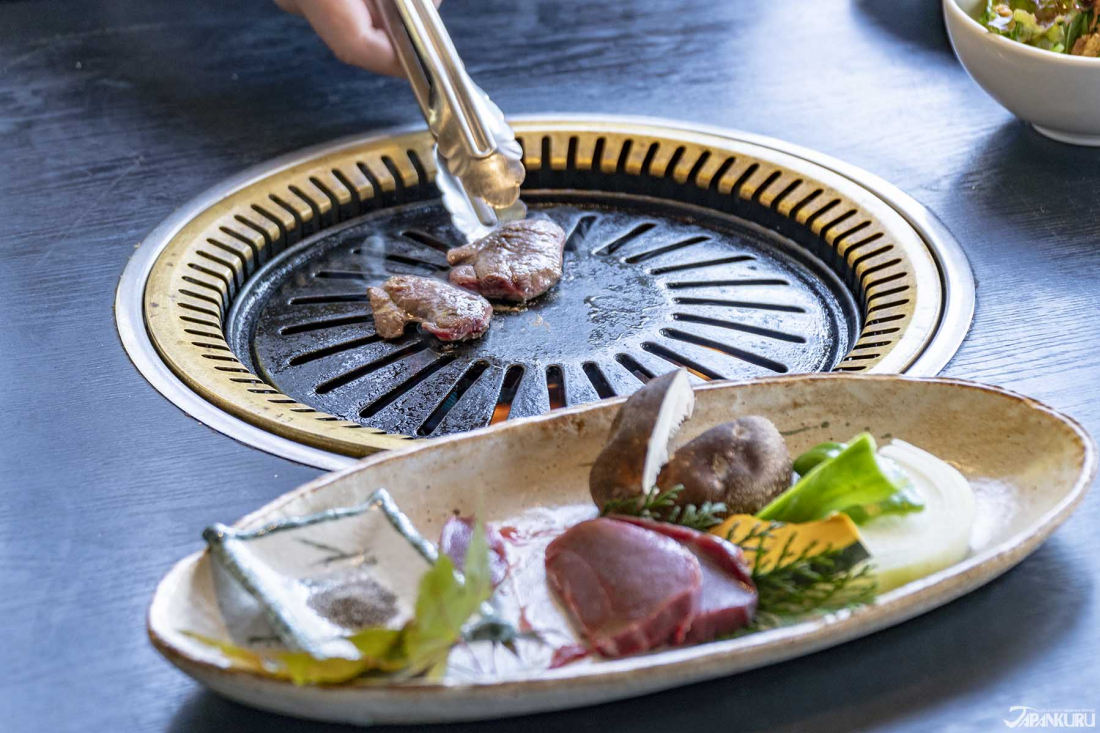
Our final stop on this unique northern Kyoto food tour was a last crack at the local venison. The delicate slices we tried on top of the buckwheat noodles at Onisobaya were pretty delectable, could anything else compete? We drove on over to Ayabe Fureai Bokujo Ranch, to see a little of the domestic animals that live on the premises, talk to Shuichi Yura from the ranch’s restaurant, and try a little bit of venison while we were there.
Yura started by telling us “Tamba is called ‘The Kitchen of Kyoto’ thanks to all the delicious ingredients that can be harvested from the region, so the local deer find plenty of good things to eat. I’d love for everyone to first taste the meat in the form of yakiniku barbeque with just a pinch of salt, which I think offers up a sense of the essential flavors of the Tamba venison.”
Seared on the grill with local produce and served with just a dash of salt, it did feel like we were tasting a whole mountain-full of flavors.
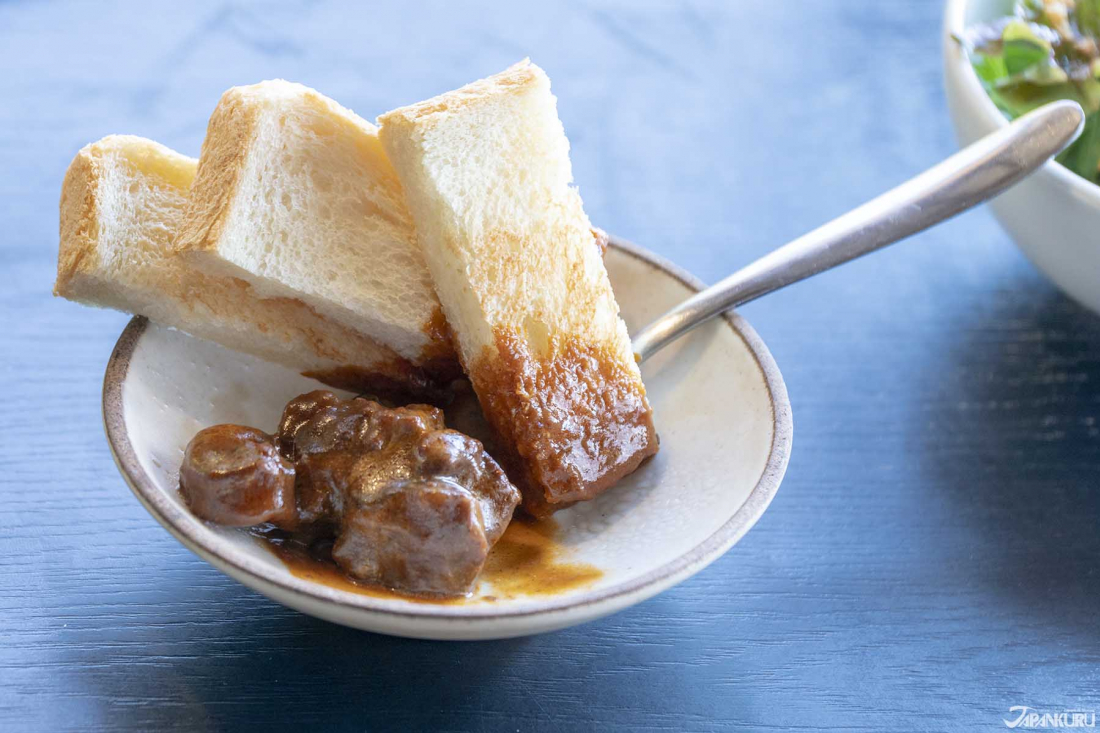
Next, Yura explained that “for the stew, we have a few tricks up our sleeves to really bring out the umami. When we were really struggling to bring the flavors of the deer meat and the stew base together, as a sort of secret ingredient we tried adding in homemade miso paste gathered from local farmers, who leave it to naturally ferment in their storehouses. It really increased the savory flavor of the venison, and turned it into the perfect addition to the stew.”
By the time we got to try the stew, they clearly had the flavor balance mastered. There was nothing strange about the pairing of the venison and the sweetly savory stew. The meat added an appropriate heartiness to the rich sauce, making for something we could imagine might be perfect for warming up on a cold night.

While the miso used in miso soup might be aged for a year or so to produce its deep flavor and umami, this stew uses miso that’s been fermenting for about ten years. It’s too strong for something like a mild soup after all that time, so there’s every chance it might have just gotten thrown away eventually. Instead of the miso going to waste, they’re using it to make some pretty delicious food!

(Don’t miss the friendly goats when you stop by!)
Ayabe Fureai Bokujo Ranch/Fureai Shokudo Heidi’s Kitchen (綾部ふれあい牧場/ふれあい食堂ハイジのキッチン)
Hinokimae-81 Idencho, Ayabe, Kyoto
Hours: 10:00 – 18:00 (~17:00 in winter)
Ayabe Tourism Page
Nearby Sightseeing
Throughout our trip all of us on the JAPANKURU team stuffed ourselves with delicious gibier cuisine, but we had some time to fill up while we digested! So we did a little sightseeing around northern Kyoto as well.
Amanohashidate (天橋立) – One of Japan’s Top 3 Scenic Views
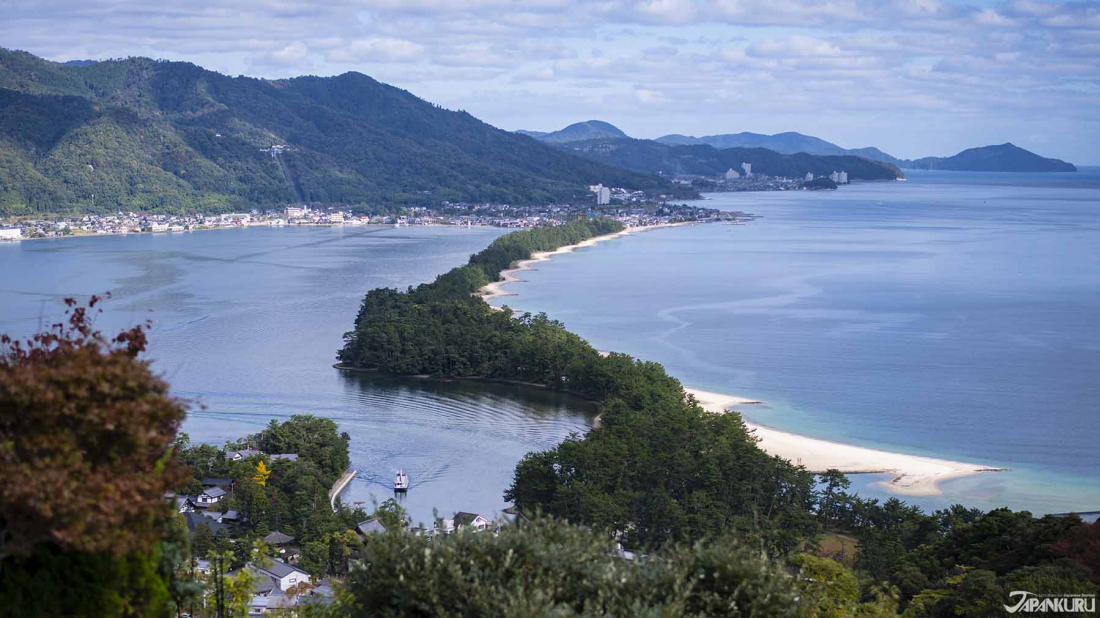
This view is said to be one of the top 3 in Japan! We’ve talked about it before, but standard practice at Amanohashidate is “matanozoki” (股覗き): bending over and looking at the view upside down through your legs. They say that from that angle, the picturesque sand bar looks like a dragon flying into the sky… or wait, was it the sea? We’re getting confused with all the blood rushing to our heads here.
Yosano (与謝野町) & the Chirimen Kaido (ちりめん街道)
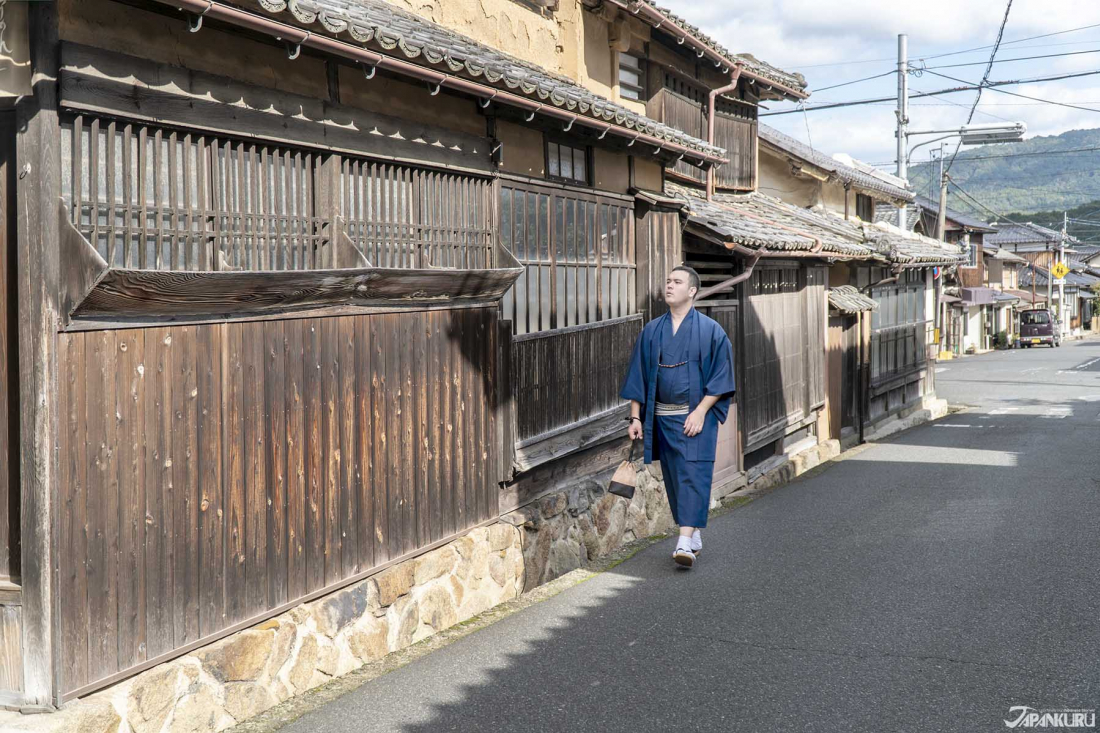
Yosano’s “Chirimen Kaido,” or “silk crepe road,” is where you’ll find the Old House of the Bito Family, a merchant family and a major presence in Japan’s raw silk crepe textile industry from the Edo period (1603 – 1868). Nowadays the area is praised for beautiful and well-preserved architecture, and the Bito house itself is known for its elegant mix of Western influences, and traditional Japanese architecture.
The city is also home to a number of shrines and Buddhist temples, giving the area a little of the tranquil ambience that is so uniquely Kyoto.
Ine (伊根)

Ine is famous for its unique funaya (舟屋) wooden boathouses, an officially-designated historic preservation site. While many traditional Japanese buildings can look a little similar, sharing a style and certain architectural quirks, these buildings are totally unique, still sitting functional on the water. You won’t find a scene quite like this anywhere else in Japan.

We ventured out onto the bay in a water taxi, admiring the truly spectacular view of the boathouses, the glittering water, and the sun setting over it all. Plus, we got to feed the seagulls shrimp chips. A little something for everyone.

And after spending that time out on the water, it only seemed appropriate to try a little taste of the sea as well. It wasn’t gibier, but this bowl of local seafood was certainly delicious!
Funeya Shokudo (舟屋食堂)
491 Hirata, Ine, Yoza District, Kyoto
Hours: 8:00 – 16:00 (closed Thursdays)
Official Website

Before leaving Ine, don’t forget to stop by Mukai Shuzo Sake Brewery! Whether it was just the color or there truly was something especially fruity to the flavor, it’s hard to tell, but when we tried a sample of the uniquely red-tinged sake of this 250-year-old sake brewery, it really did seem to have a mellow, almost wine-like flavor! (The perfect accompaniment to that venison stew, perhaps.)
Mukai Shuzo Sake Brewery (向井酒造)
67, Hirata, Ine, Yoza District, Kyoto
Hours: 9:00 – 12:00 / 13:00 – 17:00
Miyama Kayabuki-no-Sato (美山かやぶきの里)

The final stop on our itinerary was Miyama Kayabuki-no-Sato, a last look at the natural beauty of the region. This little village is full of traditional Japanese homes built out of entirely natural materials – elegant houses that were all too appropriate for a town called Miyama (美山), quite literally “beautiful mountain.” There were some shops, museums, and workshops scattered throughout the area, but we were quite content to just spend some time wandering the narrow streets, enjoying the magic of the neighborhood.
Miyama Kayabuki-no-Sato (美山かやぶきの里)
Miyamachokita, Nantan, Kyoto
Official Website
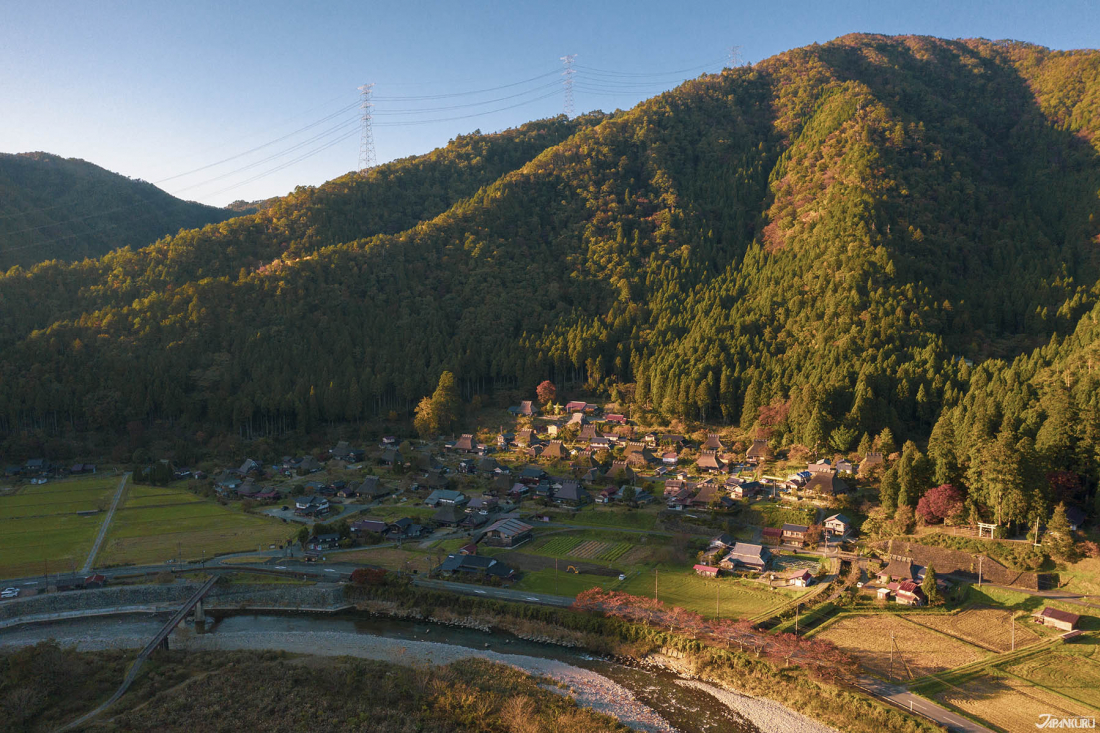
For the JAPANKURU team, this trip started with a simple interest in an unusual part of Japanese culinary culture. After touring more of northern Kyoto, though, we learned that the local traditions of maintaining and protecting the region are equally alive and important, and Kyoto gibier is just a part of that. The local citizens work hard to happily coexist with the land, and clearly express the gratitude they feel for the things they receive from nature. Gibier game meat cuisine is really just one part of the incredible local culture found in northern Kyoto to this day! (But definitely a tasty part!)
Have you tried Japanese gibier cuisine? Perhaps you’ve spent some time in northern Kyoto? Or maybe you’re planning a trip now!? Let us know about your experiences, and your new itineraries, on twitter, instagram, and facebook!
Details
NAME:Tamba Region, Kyoto
MAP
COMMENT
FEATURED MEDIA
VIEW MORE 
A New Tokyo Animal Destination: Relax & Learn About the World’s Animals in Japan
#pr #japankuru #anitouch #anitouchtokyodome #capybara #capybaracafe #animalcafe #tokyotrip #japantrip #카피바라 #애니터치 #아이와가볼만한곳 #도쿄여행 #가족여행 #東京旅遊 #東京親子景點 #日本動物互動體驗 #水豚泡澡 #東京巨蛋城 #เที่ยวญี่ปุ่น2025 #ที่เที่ยวครอบครัว #สวนสัตว์ในร่ม #TokyoDomeCity #anitouchtokyodome

Shohei Ohtani Collab Developed Products & Other Japanese Drugstore Recommendations From Kowa
#pr #japankuru
#kowa #syncronkowa #japanshopping #preworkout #postworkout #tokyoshopping #japantrip #일본쇼핑 #일본이온음료 #오타니 #오타니쇼헤이 #코와 #興和 #日本必買 #日本旅遊 #運動補充能量 #運動飲品 #ช้อปปิ้งญี่ปุ่น #เครื่องดื่มออกกำลังกาย #นักกีฬา #ผลิตภัณฑ์ญี่ปุ่น #อาหารเสริมญี่ปุ่น

도쿄 근교 당일치기 여행 추천! 작은 에도라 불리는 ‘가와고에’
세이부 ‘가와고에 패스(디지털)’ 하나면 편리하게 이동 + 가성비까지 완벽하게! 필름카메라 감성 가득한 레트로 거리 길거리 먹방부터 귀여움 끝판왕 핫플&포토 스폿까지 총집합!
Looking for day trips from Tokyo? Try Kawagoe, AKA Little Edo!
Use the SEIBU KAWAGOE PASS (Digital) for easy, affordable transportation!
Check out the historic streets of Kawagoe for some great street food and plenty of picturesque retro photo ops.
#pr #japankuru #도쿄근교여행 #가와고에 #가와고에패스 #세이부패스 #기모노체험 #가와고에여행 #도쿄여행코스 #도쿄근교당일치기 #세이부가와고에패스
#tokyotrip #kawagoe #tokyodaytrip #seibukawagoepass #kimono #japantrip

Hirakata Park, Osaka: Enjoy the Classic Japanese Theme Park Experience!
#pr #japankuru #hirakatapark #amusementpark #japantrip #osakatrip #familytrip #rollercoaster #retrôvibes #枚方公園 #大阪旅遊 #關西私房景點 #日本親子旅行 #日本遊樂園 #木造雲霄飛車 #히라카타파크 #สวนสนุกฮิราคาตะพาร์ค

🍵Love Matcha? Upgrade Your Matcha Experience With Tsujiri!
・160년 전통 일본 말차 브랜드 츠지리에서 말차 덕후들이 픽한 인기템만 골라봤어요
・抹茶控的天堂!甜點、餅乾、飲品一次滿足,連伴手禮都幫你列好清單了
・ส่องมัทฉะสุดฮิต พร้อมพาเที่ยวร้านดังในอุจิ เกียวโต
#pr #japankuru #matcha #matchalover #uji #kyoto #japantrip #ujimatcha #matchalatte #matchasweets #tsujiri #말차 #말차덕후 #츠지리 #교토여행 #말차라떼 #辻利抹茶 #抹茶控 #日本抹茶 #宇治 #宇治抹茶 #日本伴手禮 #抹茶拿鐵 #抹茶甜點 #มัทฉะ #ของฝากญี่ปุ่น #ชาเขียวญี่ปุ่น #ซึจิริ #เกียวโต

・What Is Nenaito? And How Does This Sleep Care Supplement Work?
・你的睡眠保健品——認識「睡眠茶氨酸錠」
・수면 케어 서플리먼트 ‘네나이토’란?
・ผลิตภัณฑ์เสริมอาหารดูแลการนอน “Nenaito(ネナイト)” คืออะไร?
#pr #japankuru #sleepcare #japanshopping #nenaito #sleepsupplement #asahi #睡眠茶氨酸錠 #睡眠保健 #朝日 #l茶胺酸 #日本藥妝 #日本必買 #일본쇼핑 #수면 #건강하자 #네나이토 #일본영양제 #อาหารเสริมญี่ปุ่น #ช้อปปิ้งญี่ปุ่น #ร้านขายยาญี่ปุ่น #ดูแลตัวเองก่อนนอน #อาซาฮิ

Japanese Drugstore Must-Buys! Essential Items from Hisamitsu® Pharmaceutical
#PR #japankuru #hisamitsu #salonpas #feitas #hisamitsupharmaceutical #japanshopping #tokyoshopping #traveltips #japanhaul #japantrip #japantravel

Whether you grew up with Dragon Ball or you just fell in love with Dragon Ball DAIMA, you'll like the newest JINS collab. Shop this limited-edition Dragon Ball accessory collection to find some of the best Dragon Ball merchandise in Japan!
>> Find out more at Japankuru.com! (link in bio)
#japankuru #dragonball #dragonballdaima #animecollab #japanshopping #jins #japaneseglasses #japantravel #animemerch #pr

This month, Japankuru teamed up with @official_korekoko to invite three influencers (originally from Thailand, China, and Taiwan) on a trip to Yokohama. Check out the article (in Chinese) on Japankuru.com for all of their travel tips and photography hints - and look forward to more cool collaborations coming soon!
【橫濱夜散策 x 教你怎麼拍出網美照 📸✨】
每次來日本玩,是不是都會先找旅日網紅的推薦清單?
這次,我們邀請擁有日本豐富旅遊經驗的🇹🇭泰國、🇨🇳中國、🇹🇼台灣網紅,帶你走進夜晚的橫濱!從玩樂路線到拍照技巧,教你怎麼拍出最美的夜景照。那些熟悉的景點,換個視角說不定會有新發現~快跟他們一起出發吧!
#japankuru #橫濱紅磚倉庫 #汽車道 #中華街 #yokohama #japankuru #橫濱紅磚倉庫 #汽車道 #中華街 #yokohama #yokohamaredbrickwarehouse #yokohamachinatown

If you’re a fan of Vivienne Westwood's Japanese designs, and you’re looking forward to shopping in Harajuku this summer, we’ve got important news for you. Vivienne Westwood RED LABEL Laforet Harajuku is now closed for renovations - but the grand reopening is scheduled for July!
>> Find out more at Japankuru.com! (link in bio)
#japankuru #viviennewestwood #harajuku #omotesando #viviennewestwoodredlabel #viviennewestwoodjapan #비비안웨스트우드 #오모테산도 #하라주쿠 #日本購物 #薇薇安魏斯伍德 #日本時尚 #原宿 #表參道 #japantrip #japanshopping #pr

Ready to see TeamLab in Kyoto!? At TeamLab Biovortex Kyoto, the collective is taking their acclaimed immersive art and bringing it to Japan's ancient capital. We can't wait to see it for ourselves this autumn!
>> Find out more at Japankuru.com! (link in bio)
#japankuru #teamlab #teamlabbiovortex #kyoto #kyototrip #japantravel #artnews
Photos courtesy of teamLab, Exhibition view of teamLab Biovortex Kyoto, 2025, Kyoto ® teamLab, courtesy Pace Gallery

Japanese Makeup Shopping • A Trip to Kamakura & Enoshima With Canmake’s Cool-Toned Summer Makeup
#pr #canmake #enoshima #enoden #에노시마 #캔메이크 #japanesemakeup #japanesecosmetics

⚔️The Robot Restaurant is gone, but the Samurai Restaurant is here to take its place. Check it out, and don't forget your coupon!
🍣신주쿠의 명소 로봇 레스토랑이 사무라이 레스토랑으로 부활! 절찬 쿠폰 발급중
💃18歲以上才能入場的歌舞秀,和你想的不一樣!拿好優惠券去看看~
#tokyo #shinjuku #samurairestaurant #robotrestaurant #tokyotrip #도쿄여행 #신주쿠 #사무라이레스토랑 #이색체험 #할인이벤트 #歌舞伎町 #東京景點 #武士餐廳 #日本表演 #日本文化體驗 #japankuru #japantrip #japantravel #japanlovers #japan_of_insta

Japanese appliance & electronics shopping with our KOJIMA x BicCamera coupon!
用JAPANKURU的KOJIMA x BicCamera優惠券買這些正好❤️
코지마 x 빅 카메라 쿠폰으로 일본 가전 제품 쇼핑하기
#pr #japankuru #japanshopping #kojima #biccamera #japaneseskincare #yaman #dji #osmopocket3 #skincaredevice #日本購物 #美容儀 #相機 #雅萌 #日本家電 #일본여행 #면세 #여행꿀팁 #일본쇼핑리스트 #쿠폰 #일본쇼핑 #일본브랜드 #할인 #코지마 #빅카메라 #japankurucoupon
MAP OF JAPAN
SEARCH BY REGION

LATEST
VIEW MOREEVENT CALENDAR
VIEW MORE